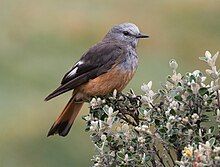Red-rumped bush tyrant
| Red-rumped bush tyrant | |
|---|---|

| |
| Cajas National Park, Ecuador | |
| Scientific classification | |
| Domain: | Eukaryota |
| Kingdom: | Animalia |
| Phylum: | Chordata |
| Class: | Aves |
| Order: | Passeriformes |
| Family: | Tyrannidae |
| Genus: | Cnemarchus |
| Species: | C. erythropygius
|
| Binomial name | |
| Cnemarchus erythropygius (Sclater, PL, 1853)
| |

| |
| Synonyms | |
|
Myiotheretes erythropygius | |
The red-rumped bush tyrant (Cnemarchus erythropygius) is a species of bird in the family Tyrannidae. It is found in Bolivia, Colombia, Ecuador, and Peru. Its natural habitats are subtropical or tropical moist montane forests and subtropical or tropical high-altitude grassland.
Description
[edit]The adult red-rumped bush tyrant is about 23 cm (9 in) long. It has a narrow beak and distinctive colouring. The fore crown is white dappled with grey, and the hind-crown and nape are grey. There is an indistinct pale streak above the eye. The back, mantle, wings and tail are slatey-brown, with the rump and base of the outer tail feathers rufous. There are two white streaks on the wings. The throat is streaked in grey and white, the breast is grey and the belly rufous.[2]
Distribution and habitat
[edit]The red-rumped bush tyrant is native to mountainous regions in South America. Its range includes the Sierra Nevada de Santa Marta and in the Andes in Norte de Santander Department and Cundinamarca State in northern and central Colombia, and the mountains of Ecuador, eastern Peru and western Bolivia. It occurs mostly in open areas with scattered trees and shrubs, at altitudes between 3,000 and 4,000 m (9,800 and 13,100 ft).[2]
Status
[edit]This bird has a very large range, the population is stable and no particular threats have been identified, so the International Union for Conservation of Nature has assessed its conservation status as being of least concern.[1]
References
[edit]- ^ a b BirdLife International (2017). "Cnemarchus erythropygius". IUCN Red List of Threatened Species. 2017: e.T22699978A110736007. doi:10.2305/IUCN.UK.2017-1.RLTS.T22699978A110736007.en. Retrieved 11 November 2021.
- ^ a b Ridgely, Robert S.; Tudor, Guy; Brown, William L. (1989). The Birds of South America: Vol. II, The Suboscine Passerines. University of Texas Press. pp. 592–593. ISBN 978-0-292-77063-8.

